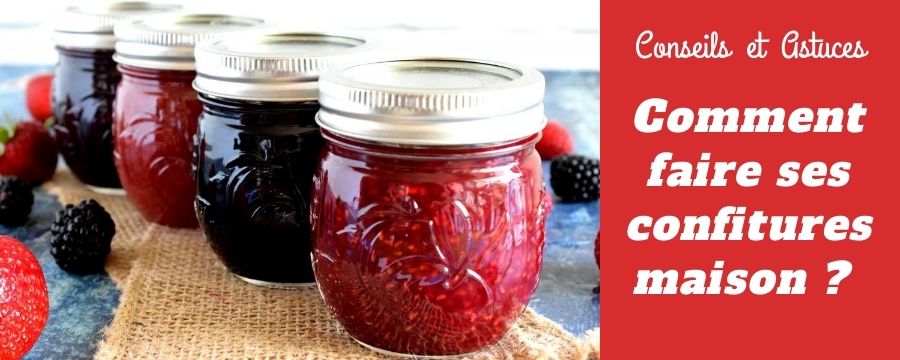
How to Make Homemade Jams?
Share
Jam is the art of preserving fruit whole or in pieces, or in the form of juice for jellies, by heating them with sugar. The sugar mixed with the pectin and the acid components of the fruit transforms this preparation into a gelling agent.
Not ripe enough, the fruit lacks flavor, but too ripe, the fruit will crumble during cooking and its pectin content will decrease. However, it is this gelling pectin , naturally present in the fruits, which allows the jam to "set". Without it, the mixture will remain liquid. The sold crates of very ripe fruit are better for making homemade compotes .

Here are some professional tips for making your homemade jams :
Which fruits contain pectin?
The amount of pectin varies depending on the variety of fruit :
- The highlights: apple, quince, currant, blackcurrant, guava, citrus fruits
- The means: apricot, raspberry, blackberry, blueberry, plum, mirabelle plum, grape
- The weak: strawberry, cherry, peach, pear, pineapple, mango
When the pectin is insufficient, professionals have several tricks to circumvent the problem:
- mix a weak fruit with a strong fruit while maintaining the harmony of flavors (raspberry + currant for example)
- infuse apple or quince seeds in the cooking jam
- use special jam sugar enriched with pectin
- add apple juice (15-20cl for 800g of fruit)
Why add lemon juice?
Lemon is a natural accomplice in the gelling of homemade jam, as it energizes the action of pectin by lowering the acidity of fruits . Lemon juice also helps preserve the taste and color of the fruit by preventing the crystallization of sugar and improving the conservation of your jam .
The juice of a small lemon, incorporated at the start of cooking or maceration , is sufficient for 1 kg of fruit. Above all, do not mix it with the special sugar enriched with pectin because they do not mix well!
What is the best sugar?
White granulated sugar is used the most, but powdered sugar and cane sugar also work. On the other hand, brown, brown or whole sugar alters the color of the fruits when cooked, to which they give a slightly caramelized taste.
Regarding the amount of sugar it is not necessary to respect the sacred recipe of our grandmothers of "tant pour tant" (50% sugar = 50% fruit). In general, it is sufficient to add between 600g and 1000g of sugar for 1kg of prepared fruit depending on the sugar content of the fruit and its acidity. The best technique is to taste regularly, adjusting until you find the perfect balance.
Unfortunately it is not possible to de-sweet your jam recipes below 600g of sugar to make a traditional jam because the taste, conservation and gelling of your homemade jam would be compromised!
How to choose a jam pan?
Your grandmother's good old copper pot is the ideal container for making your homemade jams. Its large, shallow copper basin -shaped cooking evaporation surface better preserves the taste of fruits . It also protects the pectin by preventing it from overheating and avoiding degradation.
There are now stainless steel versions but a heavy-bottomed casserole is also fine.
Jam overcooked or too runny?
A well-cooked jam does not run into the cells of the bread, but it should not have the texture of plastic either!
- For classic cooking: heat together the prepared fruit (3-4kg maximum) with the sugar and the lemon juice, until the point of gelation, after possibly resting in the cold for a few hours.
- For fruits containing little juice such as apricots, cooking in 2 stages is preferable: heat all the ingredients until the first boil then remove from the heat and cover with cling film for at least 12 hours before recooking again until to gelation .
- To best respect the taste and texture of fruits, especially delicate and fragile, we prefer the confectioners' method : immerse the prepared fruits in a syrup (water + sugar + half lemon with rind) that is already hot (105-125°C). When the jam is set, do not wait for it to cool before pouring it into your small glass jars.
When to stop cooking?
The jam only really gels when it cools because when it is hot it remains liquid. To test the cooking there are 2 methods:
- with a sugar thermometer , when the temperature rises to 105°C stop cooking and let your preparation cool.
- with a cold plate, pouring a drop of hot jam on it. By tilting the plate, the drop of jam should not slide but freeze.

How to store homemade jam?
You must first scald your glass jars and lid for about ten minutes then let them dry upside down on a clean cloth. They will then be filled to the brim with very hot jam using a funnel or a glass carafe. Screw the lids on then turn the jars over immediately and leave to cool completely on the work surface. At the opening, the sound of the small "clac" indicates that the self- pasteurization is successful!
Do it yourself !
Now you know how to make your traditional jam easily and quickly. By preparing your homemade recipe, you control the amount of sugar that is often too high on the market by making low-fat homemade jams . Keep your old-fashioned jams until the next season of your favorite fruits !







